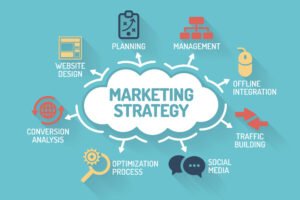How Do You Explain Promotion in Marketing Mix: A Complete Guide

Promotion within the marketing mix represents the strategic communication component that connects businesses with their target audiences. This element encompasses all methods companies use to inform, persuade, and remind customers about their products or services.
The promotion element works alongside product, price, and place to create a comprehensive marketing strategy. While other components focus on what you offer and how customers access it, promotion determines how effectively you communicate value to potential buyers.
Understanding promotion’s role becomes essential for creating marketing campaigns that drive awareness, generate interest, and ultimately convert prospects into paying customers. This component often determines whether excellent products succeed or fail in competitive markets.
Core Functions of Promotion in Marketing
Communication serves as promotion’s primary function, bridging the gap between business offerings and consumer needs. Companies must clearly articulate how their products solve specific problems or fulfill particular desires their target market experiences.
Persuasion represents another crucial promotional function, influencing customer attitudes and purchase decisions through compelling messaging and strategic positioning. Effective promotional strategies address customer objections while highlighting unique benefits and competitive advantages.
Reminder activities keep existing customers engaged and encourage repeat purchases while maintaining brand awareness among previous buyers. This ongoing communication prevents competitors from capturing established customer relationships through better visibility or messaging.
Traditional Promotional Methods
Advertising through various media channels remains a cornerstone of promotional strategy for most businesses. Television, radio, print publications, and outdoor advertising provide broad reach capabilities that build brand recognition across large audience segments.
Personal selling involves direct interaction between sales representatives and potential customers, allowing for customized presentations and immediate objection handling. This approach works particularly well for complex or high-value products requiring detailed explanation.
Public relations activities generate earned media coverage and build credibility through third-party endorsements. Press releases, media events, and community involvement create positive brand associations that paid advertising alone cannot achieve.
Digital Age Promotional Evolution
Online advertising has transformed promotional possibilities through precise targeting, real-time optimization, and measurable results. Search engine marketing, social media advertising, and display campaigns offer unprecedented control over audience reach and message delivery.
Content marketing represents a shift toward providing value before requesting purchases, building trust and authority through helpful information. Blog posts, videos, podcasts, and educational resources attract customers by addressing their questions and challenges.
Social media engagement creates two-way communication channels that humanize brands and foster community building. Platforms enable direct customer interaction, user-generated content, and viral marketing opportunities that traditional media cannot replicate.
Integration with Other Marketing Mix Elements
Product promotion must align with actual product features and benefits to maintain credibility and customer satisfaction. Overpromising through promotional messages creates disappointed customers and damages long-term brand reputation.
Pricing strategies directly influence promotional messaging and channel selection. Premium products require different promotional approaches than budget offerings, with messaging emphasizing value rather than just affordability.
Distribution channels affect promotional reach and effectiveness since different audiences consume media through varying preferences and behaviors. Promotional strategies must consider where target customers spend their time and attention.
Budgeting for Promotional Activities
Promotional budgets typically represent significant portions of overall marketing investments, requiring careful allocation across different channels and tactics. Companies must balance broad awareness building with targeted conversion-focused activities.
Return on investment calculations help determine which promotional methods deliver the best results for specific business objectives. Tracking systems must connect promotional activities to actual sales outcomes and customer acquisition metrics.
Seasonal variations and competitive pressures influence promotional spending patterns throughout the year. Businesses often increase promotional budgets during peak selling seasons while maintaining baseline awareness activities during slower periods.
Measuring Promotional Effectiveness
Awareness metrics track how well promotional activities increase brand recognition and recall among target audiences. Surveys, brand tracking studies, and unaided recognition tests provide insights into promotional impact on customer consciousness.
Engagement measurements reveal how audiences interact with promotional content across different channels and formats. Click-through rates, social media interactions, and content consumption patterns indicate message resonance and audience interest levels.
Conversion tracking connects promotional exposure to actual purchase behavior, providing the most direct assessment of promotional return on investment. Attribution modeling helps understand how different promotional touchpoints contribute to customer acquisition and retention.
Target Audience Considerations
Demographic factors influence promotional message development and channel selection since different age groups, income levels, and geographic regions respond to various communication approaches differently.
Psychographic characteristics including values, interests, and lifestyle preferences guide promotional tone, imagery, and platform choices. Understanding what motivates your audience enables more effective persuasive messaging.
Buyer journey stages require different promotional approaches as customers move from awareness through consideration to purchase decisions. Early-stage promotion focuses on education while later stages emphasize conversion optimization.
Promotional Campaign Development
Campaign objectives must align with broader business goals while providing specific, measurable targets for promotional activities. Clear objectives guide creative development, channel selection, and success measurement approaches.
Creative strategy development involves crafting compelling messages that resonate with target audiences while differentiating from competitive offerings. Successful campaigns balance emotional appeal with rational benefits communication.
For comprehensive promotional strategies that integrate seamlessly with your marketing mix, explore proven techniques at Course Promotion where you’ll find expert guidance on maximizing promotional effectiveness.
Common Promotional Mistakes
Inconsistent messaging across different promotional channels confuses audiences and weakens overall campaign effectiveness. Brand voice, key messages, and visual identity must remain consistent regardless of specific promotional tactics employed.
Neglecting audience research leads to promotional campaigns that fail to resonate with intended recipients. Understanding customer preferences, media consumption habits, and decision-making processes is essential for promotional success.
Focusing solely on immediate sales rather than building long-term relationships often results in short-term promotional gains followed by customer acquisition challenges. Balanced approaches consider both immediate and future customer value creation.
Future Promotional Trends
Personalization capabilities continue expanding through data analytics and artificial intelligence, enabling highly targeted promotional messages that speak directly to individual customer needs and preferences.
Interactive promotional formats engage audiences more deeply than traditional one-way communication methods. Augmented reality, interactive videos, and gamified experiences create memorable brand interactions that drive stronger customer connections.
Privacy regulations and consumer preferences toward data protection require promotional strategies that respect customer privacy while still delivering relevant, valuable communication experiences.
Promotional Strategy Optimization
Testing different promotional approaches helps identify the most effective combinations of messaging, timing, and channel selection for specific audience segments and business objectives.
Competitive analysis reveals promotional opportunities and threats while providing insights into industry best practices and emerging trends that could enhance your promotional effectiveness.
Continuous refinement based on performance data ensures promotional strategies remain relevant and effective as market conditions, customer preferences, and competitive landscapes evolve over time.



